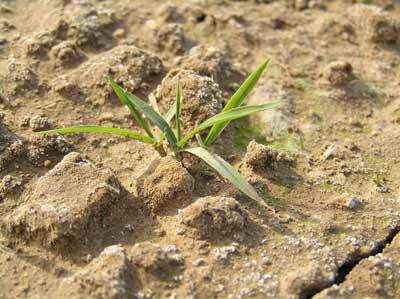|
Vol 34-6 April May 2013
ESTABLISHING NATIVE GRASSES -
Cool Season Types
by Ian Chivers- Native Seeds
Cool season grasses are those that establish best in months when moisture is readily available to the seed. They include such beneficial native grasses as weeping grass, wallaby grass and wheat grass.
To ensure a good result with seeding of these species follow the steps below.
Have the weeds under control – all seedlings need to have a competition-free environment to allow them to get established, but this is especially true for the slower-growing native grass seeds. Start early and use whatever means you desire; cultivation, herbicides or combinations. Simply overgrazing is not sufficient to control weeds as this only removes the green leaf and usually does not kill the plant.
It is often best to allow a flush of weeds to germinate with the first rains of the autumn and then to kill them off prior to sowing the native grass seeds. This removes a good percentage of the weed seeds from within the soil, which helps with good establishment of the desired native grasses.
Create a seedbed– the seeds will not germinate or establish well if they are simply broadcast onto a hard surface or existing foliage. For good germination seed needs to be in close contact with soil and leaving seed exposed on the surface will give very poor germination results. Equally, it is not essential that a full seedbed be prepared. Roughing the surface with a set of harrows will create little grooves and provide the seeds with niches in which to get off the surface.
Bury the seed – all grass seeds seem to germinate best if they are covered lightly with soil or a compost. They do not need to be covered with more than 3 to 5 mm of soil, just sufficient to keep them underground. Heavy mulching with an uncomposted mulch will usually not give good results, but well-degraded compost usually works well.
Moisture – this is the key to success or failure. The cool season types all need to have constant moisture around the seed. While the warm season grasses are able to germinate with spasmodic rainfall or irrigation, the cool season types do not. They need to be kept moist, therefore sowing only in late autumn through winter and into early spring is recommended. Once the evaporation rates rise in late spring, germination rates of the cool season types quickly fall. Although these grasses are great at persisting under dry conditions once established, they will not get well established in dry conditions.
Know what you are looking for - it will be difficult to recognise success or failure without knowing what the seedlings look like. Sow a small amount of the same seed in a pot at the same time as it is sown in the paddock. This will need regular watering to get germination, but it will help to identify what seedlings are emerging in the field i.e. which ones are weeds and which are the native grasses. Better still is to complement this with an in-field test row of the seed. Use a generous amount of seed in a narrow row about half a metre long and mark with a stick at each end. Then, as long as the area where it is sown is typical of the rest of the paddock, this will show exactly what the seedlings look like in the field and how they are developing.
Be patient – the seedlings of the native grasses are not as fast to establish as the introduced grasses. Persistence and patience are required to get the desired result. This means not grazing until the plants are well established, and that means really well established, not just having five leaves or so, but as a robust plant with a strong root system.
Sow good quality seed – with native grass seed, as with most things, you get what you pay for. Always ask for a purity and germination certificate seed and, if necessary, ask for an explanation to interpret it. High quality seed (high germination rate with very few weeds) will always give a better result than low quality seed and seed grown from purposely grown crops will always have higher vigour than those from wild collections.
|